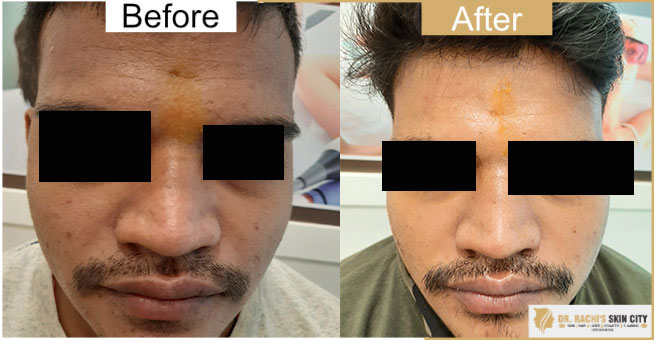The Singular Benefit of Chemical Peel, Radiant Skin Revitalization
In the realm of skincare, chemical peels have emerged as a captivating solution for achieving radiant and revitalized skin. The growing popularity of these treatments reflects an increasing interest in unlocking the singular benefit that sets chemical peels apart in the world of skincare.
Understanding the Chemistry: How Chemical Peels Work
Chemical peels harness the power of carefully selected acids to exfoliate and rejuvenate the skin. Alpha hydroxy acids (AHAs), beta hydroxy acids (BHAs), and trichloroacetic acid (TCA) are commonly used, each addressing specific skin concerns. By applying a chemical solution to the skin, damaged layers are gently peeled away, revealing a smoother, more even complexion beneath.

Revitalizing the Skin: The Transformative Power
The primary allure of chemical peels lies in their transformative power to revitalize the skin. Whether combating sun damage, addressing pigmentation issues, or minimizing fine lines and wrinkles, chemical peels offer a comprehensive solution. The exfoliation process not only removes dead skin cells but also stimulates the production of new, healthy skin cells, fostering a radiant and youthful appearance.
Customized Solutions: Tailoring Peels to Individual Needs
One of the remarkable aspects of chemical peels is their versatility in addressing a spectrum of skincare needs. Dermatologists can customize treatments based on individual concerns, whether it’s combating acne scars, reducing hyperpigmentation, or achieving an overall skin refresh. This tailored approach ensures that the singular benefit of each peel aligns with the specific goals of the individual, contributing to a more personalized skincare experience.
The Deep Dive: Peeling Away Imperfections
To truly grasp the transformative power of chemical peels, it’s essential to understand their action on a cellular level. As the chemical solution is applied, it penetrates the skin, triggering controlled exfoliation. This process removes damaged outer layers, unveiling fresher skin underneath. By peeling away imperfections, chemical peels stimulate collagen production, promoting firmer and more youthful skin.
Beyond Aesthetics: Additional Benefits for Skin Health
While the primary focus of chemical peels is often aesthetic, their benefits extend beyond surface-level improvements. The stimulation of collagen and elastin during the peeling process contributes to increased skin elasticity. This can lead to a reduction in the appearance of fine lines and wrinkles, providing both aesthetic enhancements and long-term improvements in skin health.
Navigating Concerns: Safety and Side Effects
While the benefits of chemical peels are undeniable, it’s natural for individuals to have concerns about safety and potential side effects. Understanding these aspects is crucial for anyone considering this skincare treatment. Generally, chemical peels are safe when performed by trained professionals. Common side effects may include redness, peeling, and temporary discomfort. However, these effects are usually transient and can be minimized with proper aftercare.
Recovery and Aftercare: Ensuring Optimal Results
A smooth recovery is integral to maximizing the benefits of chemical peels. Following a treatment, it’s essential to adhere to specific aftercare instructions provided by your dermatologist. This may include avoiding sun exposure, using gentle skincare products, and staying hydrated. By prioritizing proper aftercare, individuals can ensure optimal results and minimize the risk of adverse reactions.
Professional vs. At-Home: Weighing the Options
The decision between professional chemical peel treatments and at-home options depends on individual preferences, budget, and the severity of skin concerns. Professional treatments offer the expertise of trained professionals and may involve deeper peels for more significant results. On the other hand, at-home options provide convenience and a milder approach. Understanding the pros and cons of each option empowers individuals to make informed choices aligning with their skincare goals.
Frequently Asked Questions About Chemical Peels
1. What is a chemical peel, and how does it work?
A chemical peel is a skincare treatment that uses acids to exfoliate and rejuvenate the skin. It works by applying a chemical solution to peel away damaged skin layers, revealing a smoother complexion.
2. Are chemical peels suitable for all skin types?
Chemical peels can be adapted for various skin types. Your dermatologist will customize the peel based on your specific needs, considering factors like sensitivity and skin concerns.
3. What are the primary benefits of getting a chemical peel?
The primary benefits include skin revitalization, addressing pigmentation issues, reducing fine lines and wrinkles, and promoting the production of healthy skin cells for a youthful appearance.
4. Are there different types of chemical peels?
Yes, chemical peels come in various types, such as Alpha Hydroxy Acids (AHAs), Beta Hydroxy Acids (BHAs), and Trichloroacetic acids (TCAs), each targeting specific skin concerns.
5. Is there any downtime after a chemical peel?
There may be mild downtime, depending on the peel’s intensity. Redness and peeling are common but temporary. Following proper aftercare instructions minimizes downtime.
6. Are chemical peels safe?
When performed by trained professionals, chemical peels are generally safe. Side effects like redness and discomfort are usually temporary and can be minimized with proper aftercare.
7. Can chemical peels help with acne scars?
Yes, chemical peels can be effective in reducing the appearance of acne scars by promoting the growth of new, healthy skin cells and improving overall skin texture.
8. How often should I get a chemical peel?
The frequency depends on your skin type and concerns. Generally, once every 4-6 weeks is suitable, but your dermatologist will provide personalized recommendations.
9. Can I combine chemical peels with other skincare treatments?
Combining chemical peels with other treatments may enhance results. However, it’s crucial to consult with your dermatologist to ensure compatibility and avoid over-treatment.
10. Are at-home chemical peels as effective as professional ones?
At-home options offer milder results compared to professional treatments. The choice depends on individual preferences, budget, and the severity of skin concerns.
Conclusion:
In conclusion, the singular benefit of chemical peels lies in their ability to transform and revitalize the skin. From tailored solutions to a deep dive into cellular rejuvenation, chemical peels offer a holistic approach to skincare. While addressing aesthetic concerns, they also contribute to overall skin health, providing a comprehensive solution for those seeking radiant and youthful skin.




